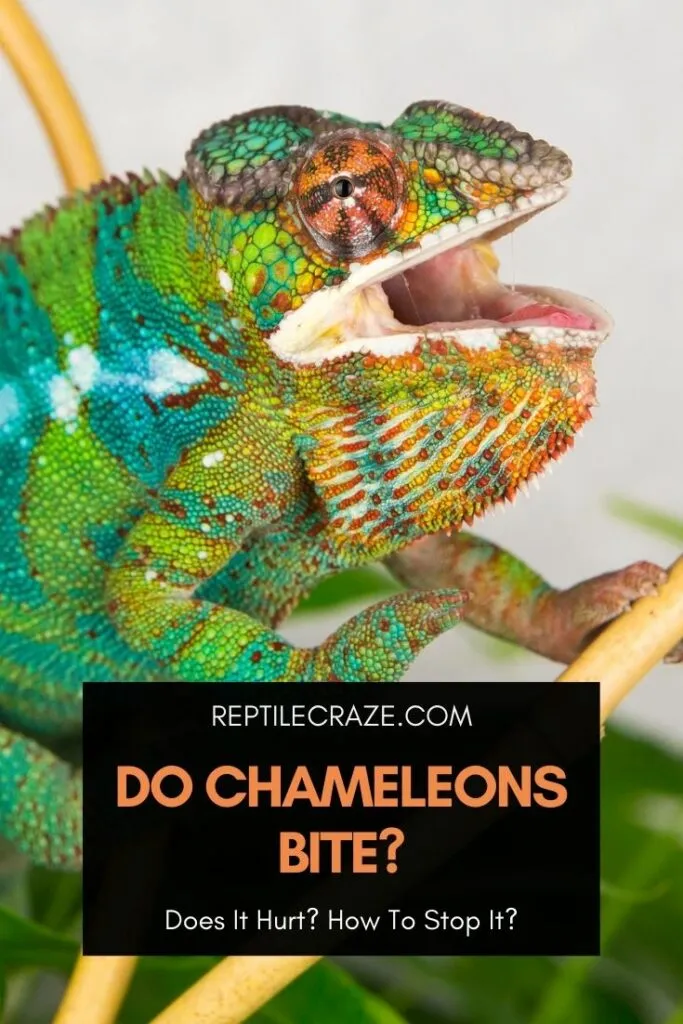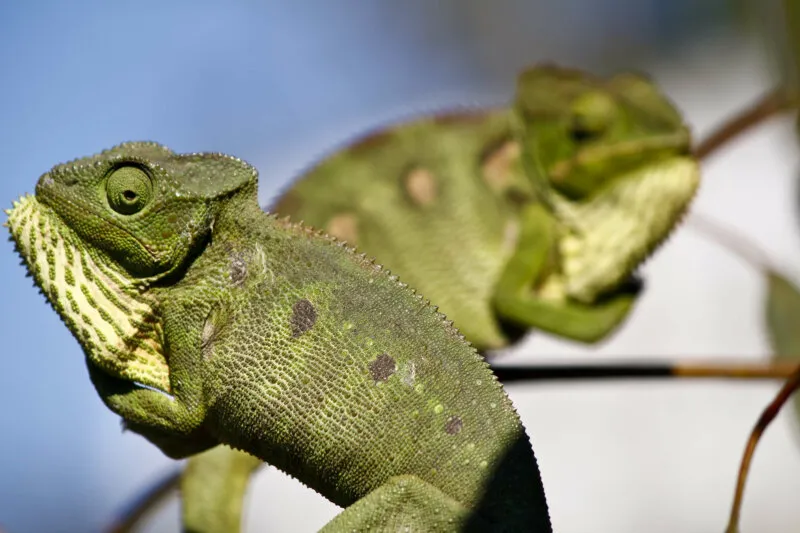
Chameleons make beautiful and entertaining pets, thanks to their bright colors and comical expressions. But are they good pets to handle and pet, or are they likely to cause injury? Today we are going to talk about the chances of chameleons biting, how risky this is, and how to prevent it.
Chameleons are unlikely to bite, but can. They forewarn with color changes, gaping mouth, and hissing. Meller’s, Veiled, and Panther chameleons, are more likely to bite than other species. Males are more likely to bite than females. Chameleon bites are not serious nor venomous, though they can hurt.
So that is the simple answer, but there’s a lot more to discuss. There are many different chameleon species that are kept as pets, all with different temperaments and chances of biting. Some can be trained to be more docile, while others can’t. Let’s find out more.
Table of Contents
It Is Unlikely To Get Bitten By A Chameleon
Yes, chameleons bite. All animals with mouths have the potential to bite. This is a natural part of any animal’s behavioral range and needs to be accepted as a possibility. What we really want to know is “how likely is my chameleon to bite me?”
The answer can vary wildly depending on many factors. These include the species of chameleon, the sex of the chameleon, the situation, what the chameleon has experienced in the past, and its individual personality.
Luckily, though, the general answer is that a pet chameleon is unlikely to bite often.
Fighting is very dangerous for all animals. Even if they win a fight, they may be injured and risk weakening themselves.
For this reason, animals always have a series of behaviors that they display before they make physical contact such as a bite. For a tiny chameleon, taking the risk of biting a huge predator like you is something they really want to avoid.
Which Chameleons Are Most Likely To Bite?
Let’s look closely at the stereotypical temperament of some common species of male pet chameleons and compare which is most likely to bite.
| Chameleon Species | Male |
| Veiled Chameleon (Chamaeleo calyptratus) | This is one of the biggest species of chameleon and therefore has a larger jaw and more powerful bite. Males are one of the most aggressive chameleons that are kept as pets and are very territorial. |
| Panther Chameleon(Furcifer pardalis) | This chameleon is a very popular pet. It is brightly colored and less aggressive than the Veiled, but still territorial. |
| Jackson’s Chameleon(Trioceros jacksonii) | This chameleon is extremely territorial and aggressive to other males, but is pretty nervous of humans. They are more likely to be skittish than to bite you. If they do, they give clear warning signs and move to bite slowly. |
| Fischer’s Chameleon(Kinyongia fischeri) | This chameleon is active and entertaining, but uninterested in humans. More likely to be skittish than to bite. |
| Carpet Chameleon(Furcifer lateralis) | This chameleon is very territorial and aggressive to both males and females who are not receptive. They are nervous, easily stressed and don’t take handling well. Likely to be fast and skittish. |
| Oustalet’s Chameleon(Furcifer oustaleti) | This is the biggest species of chameleon and therefore has a larger jaw and more powerful bite. Luckily it has a placid temperament and is less likely to bite than Veileds and Panthers. |
| Meller’s Chameleon(Trioceros melleri) | This is one of the biggest species of chameleon and therefore has a larger jaw and more powerful bite. It is easily stressed. Opinions are divided on this one. It seems some are notably docile, while others are notably aggressive. |
| Four-Horned Chameleon(Trioceros quadricornis) | This species is less aggressive, even towards one another. It is more placid and unlikely to bite, but may hide. |
| Senegal Chameleon(Trioceros quadricornis) | This species is shy, easily stressed, and not very active. Though they are unlikely to bite humans, they are very territorial to other male chameleons. |
| Rudis Chameleon(Trioceros rudis) | This chameleon is purported to be one of the most docile and is very unlikely to bite. |
Do Female Chameleons Bite?
Generally speaking, female chameleons are mellower versions of their male counterparts and are less likely to bite.
This is because they feel less defensive of territory and are not paranoid that a competing male might be about to fight them at any moment. Bear in mind though, that this is a general rule and not a guarantee.
When gravid and laying eggs, females can become very defensive and act more aggressively. They are much more likely to bite during this time.
Top 3 Chameleons That Are Most Likely To Bite
- Veiled Chameleon (Chamaeleo calyptratus)
The Veiled Chameleon is known to have a grumpy temperament and to deliver one of the stronger bites out of the pet chameleon species.
- Meller’s Chameleon (Trioceros melleri)
Some owners report that their Meller’s Chameleons are laid-back and tolerate handling well. Unfortunately, those that have aggressive Meller’s Chameleons say that they are very aggressive indeed. As they are a very large chameleon species, their bite is more serious. These chameleons are not recommended for beginners.
- Panther Chameleon (Furcifer pardalis)
The Panther Chameleon is an exceptionally beautiful and popular pet. They can certainly be grumpy, but are generally regarded as being more mellow than the Veiled, and a little less likely to bite.
Top 3 Chameleons That Are Least Likely To Bite
- Rudis Chameleon (Trioceros rudis)
The Rudis Chameleon is known to be a very pleasant pet and quite docile. It tolerates handling well (for a chameleon).
- Four-Horned Chameleon (Trioceros quadricornis)
The Four-Horned Chameleon is an all-around less aggressive chameleon species and is less reactive.
- Oustalet’s Chameleon (Furcifer oustaleti)
Oustalet’s Chameleons are the biggest chameleons and are pretty confident and laid back. They tend to be more placid than the other large chameleons.
What Does It Look Like When A Chameleon Is About To Bite You?
Chameleons are kind enough to give you a range of signals that warn you that a bite is coming, before they actually chomp down. If you learn to pay attention to what your chameleon is telling you, you will be able to read these warning signs and stop what you are doing before a bite occurs. This is all part of building a relationship of trust with your pet.
Signs that precede a bite are:
- Color changes – From the resting colors to vibrant colors, dark brown or dark black.
- Turning side-on toward you. – Making their bodies slim and tall so as to look large and display colors to you.
- Mouth gaping. – Opening the mouth wide at you.
- Hissing. – Making threatening sounds.
- Feinting – Lunging to bite and “missing”.
- Threatening – Slowly reaching out to bite, giving you time to move away.
Check out the video below to see these signs in action. Notice, though, that the chameleon takes the first opportunity to run away. It really doesn’t want to take the risk of biting, but simply wants to be left alone.
Does It Hurt When Chameleons Bite?
There are many species of chameleon, and many of them are very small. Tiny chameleons have small, weak jaws, and don’t particularly hurt when they bite.
However, the species that most pet owners have are some of the largest chameleon species. As a result, bites from pet chameleons do tend to hurt.
Pet chameleon bites can cause pinches, bruises, and break the skin, drawing blood. Fortunately, physical injury is the only immediate danger. Nonetheless, you should still treat a bite as any other injury.
It needs to be cleaned, disinfected, and if there is an open wound it should be covered to prevent infection. Luckily, chameleons don’t carry any specific diseases that can be passed to you in a bite.
Are Chameleon Bites Venomous? Or Poisonous?
Chameleon bites are not venomous. Being ‘not venomous’ means that if they bite you, you will not be sickened by a toxin (venom), as they have none to attack you with.
Chameleons are not poisonous. If a human or an animal bites or eats a chameleon, they won’t swallow any toxin (poison) that could cause them to become ill or die. However, chameleons carry salmonella and could give a human
So we are pretty sure that you won’t eat your chameleon. However, you should also make sure that none of your other pets bites or even eats your chameleon when you handle your chameleon.
Can A Chameleon Bite Your Finger Off?
A chameleon bite is not powerful enough to cleave bone and actually bite off a finger. Nowhere near strong enough. However, the bite of a bigger species can do some flesh damage. In extremely rare cases the wound might need stitches.
Don’t worry though, as a regular “bad bite” looks something like the pictures shown in the video below at around 40 seconds. Not so bad, really, when you consider the damage a rabbit can do!
Do Chameleons Have Teeth?
Yes, chameleons have tiny little teeth designed for chewing up insects. These teeth are so small that they can be difficult to see with the naked eye.

Chameleon teeth are acrodont, which means that they don’t have roots like mammal teeth. Instead, they are fused together at the bases and joined to the alveolar ridge of the jaw. This type of tooth can be found in many reptiles, bony fish, and some amphibians.

Chameleons only get one set of teeth for their whole lives. As a result, if they wear down, eating may become difficult. However, thanks to the structure of the teeth and jaw, the alveolar ridges continue to function fairly well even when teeth have worn down.
Chameleon tooth care is fairly straightforward. Ensuring good calcium supplementation and taking them for their yearly vet check should do the trick. The vet may brush your chameleon’s teeth, but don’t try to do this yourself at home.
Newly hatched chameleons even have a very special tooth called the egg tooth. This tooth is used by the baby chameleon to cut the shell membrane and break out. The tiny egg tooth is often broken off during this process, but you can see it on some hatchlings.
Why Do Chameleons Bite And How Can You Stop It?
Chameleons bite for one simple reason. They didn’t want you close to them, you didn’t back away when they signaled that you should, so now their last resort is to bite you.
If you watch their behavior closely and give them space when they ask, you are almost certainly not going to get bitten.
Unfortunately, it isn’t always possible to give them space. For example, you may need to move them, clean their habitat, or transport them to the vet. Also, you may simply want to handle them a little and build a trust relationship.
Luckily, there are some known factors that can cause your chameleon to be:
- Less tolerant of you being close to them.
- More anxious and reactive.
- More aggressive and territorial.
And the good news is that you can control many of the factors that cause these problems. If you address the following points, your chameleon may well become more relaxed, less likely to show aggressive signals, and ultimately, less likely to bite.
Acute Fear
Your chameleon reacts to fear with a fight or flight response, just like you. In most cases, when startled or faced with perceived danger, it will run away and hide. However, if your chameleon is cornered and has nowhere to run, it has no choice but to show aggression and could bite.
Similarly, if you pick it up from above, it is going to react as a wild chameleon would when grabbed by a predator. It is going to fight for its life!
You can avoid these problems by approaching your chameleon slowly and from the front. If you need to reach into the habitat, make sure your chameleon is not exposed in the open, nor trapped with nowhere to go.
When you pick up your chameleon, do so by allowing it to crawl onto your hand.
Another great tip is to approach when your chameleon is higher up than you. As a tree-dwelling species, they feel more secure when they have the high ground.
Social Stress
If your chameleon is inappropriately housed together with other chameleons, it is going to be stressed and defensive. If it is housed alone, but can see another chameleon, it can feel stressed and defensive.
This stress is bad for the health of your chameleon and is definitely going to make it more reactive and aggressive. It is likely to bite as a result of this stress. You should consider screening off adjacent tanks and certainly should house your chameleons individually.

Reproductive Stress
Female chameleons can be extremely defensive when gravid. They are weakened by the process of making and laying eggs, and are naturally protective of the eggs themselves, until they have been safely buried. She is very likely to bite you if you get too close.
Be sensitive with your female chameleon during this time. She needs extra space, extra patience, and extra calcium!
Environmental Stress
Another common cause of stress for chameleons comes from their environment. If they do not have an appropriate amount of space, or the ambient temperature, lighting, or humidity is wrong, this will cause chronic stress.
Chronic stress manifests as illness, eventually leading to stunted growth, suppressed immune response, and a shortened life span. It also causes your chameleon to be fearful and aggressive, making it much more likely to bite.
If your chameleon has started becoming more aggressive, and perhaps showing other signs of illness, assess every element of your housing setup and consider how it could be improved.
Over Handling
Chameleons do not like to be handled or petted. Some are more tolerant of it than others, but that is not the same as enjoying it. Chameleons are solitary animals and have no behavioral adaptation for showing affection like us primates. They simply don’t understand it or benefit from it.
If your chameleon is biting, especially if the aggression is limited to when you pick it up and handle it, consider whether you really need to be handling it.
Chameleons are definitely more of a decorative pet than an affectionate one. Of course, there are things you can do to improve your chameleon’s tolerance to handling.
How To Improve Your Chameleon’s Tolerance To Handling
The key to improving your chameleon’s tolerance to handling is to ensure that their experience of being close to you is always positive. Don’t ever try to handle your chameleon when it is already showing signs of stress, anxiety, or aggression, or those feelings will be associated with you.
Instead, try to associate yourself with the delivery of things the chameleon wants, like
Whatever you have observed your chameleon enjoying alone, you can try to associate with your presence. After some time, your chameleon will become more assured that you are not a threat and will always deliver good things.
Many chameleon owners use hand feeding to build this trust relationship. You can also reserve your chameleon’s favorite treats to be given during petting or handling.
While this won’t result in a chameleon that loves handling, it will help them to become more confident, calm, and tolerant. Take this process slowly, and don’t set your expectations too high.
Also, bear in mind that some types of chameleon are more receptive to handling, as discussed above. In addition, chameleons have individual personalities just like us.
You may have a particularly sassy pet, or a surprisingly friendly one. It’s all the luck of the draw, and making these discoveries is half the fun of keeping chameleons.
- Enchi Ball Python: A Unique and Stunning Morph of Python regius - March 27, 2025
- Emerald Tree Monitor: The Enigmatic Green Guardian of the Rainforest - March 26, 2025
- The Egyptian Cobra (Naja haje): A Fascinating Serpent - March 25, 2025
